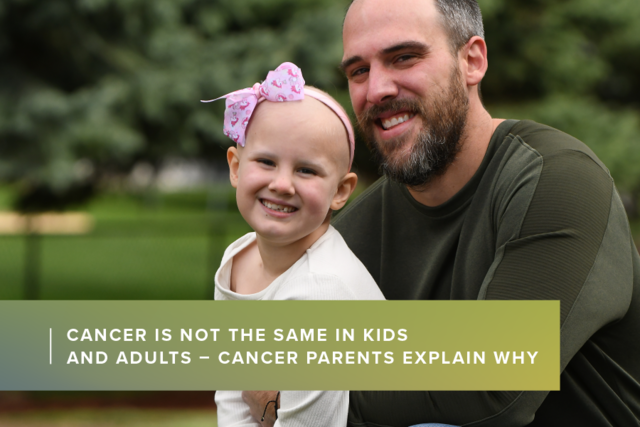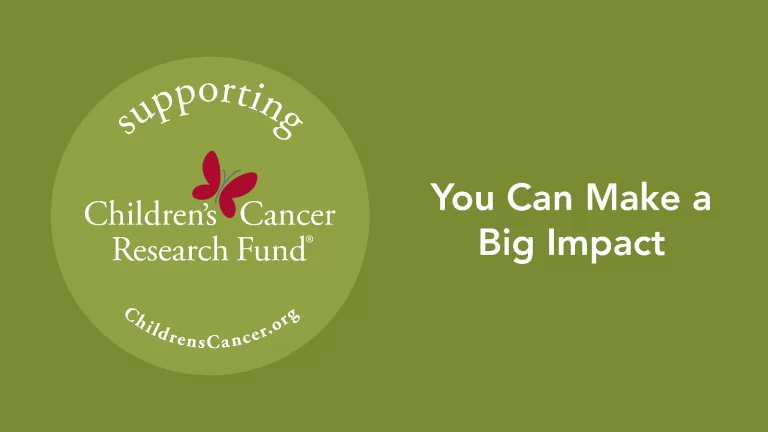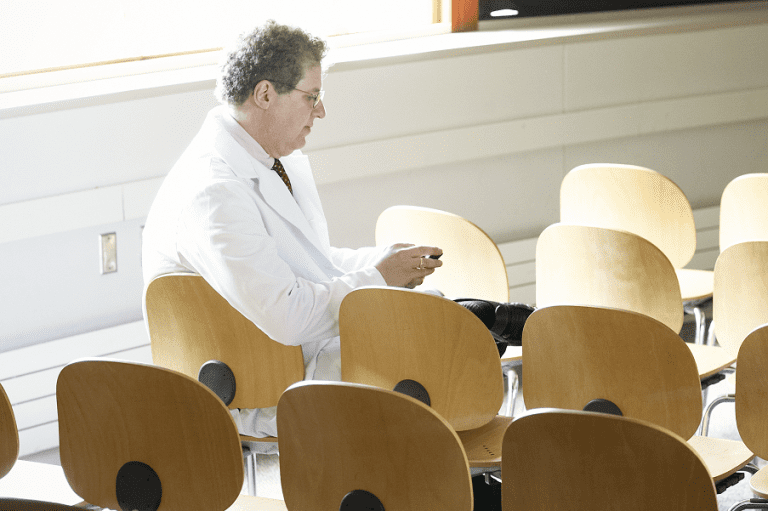This blog post was supported by our partner, Minnesota United. For the third year running, CCRF is the recognized cause for the Minnesota United's Kick Childhood Cancer initiative and game, this year on September 18th! Visit the team store at Allianz field where a "register round-up" will benefit CCRF. Learn more here.
No matter what age someone is at diagnosis, cancer is devastating. But when it comes to treatment and research, childhood cancers and adult cancers are not the same. In honor of Childhood Cancer Awareness Month this September, we asked a handful of cancer parents to help explain why cancer in kids is different than cancer in adults – and what you can do to help kids fighting cancer.
Behavior and lifestyle rarely, if ever, factor into why a child develops cancer.
When we see all the campaigns that are aimed at screening for adult cancers, or changing behaviors that can lead to cancer, you might ask: why aren’t we doing the same for cancer in kids? Well, most of the time, childhood cancers weren’t caused by any behavioral or environmental factors (like smoking, overexposure to the sun or being exposed to toxic chemicals). In fact, there are some childhood cancers that begin developing before the child is even born.
“While lifestyle can factor into adult cancers, there isn't a lifestyle factor at play in childhood cancer development. Sometimes it can be traced to genes, but most often it is a mystery why and how a child developed cancer. I did spend a lot of time wanting to know why, because I didn't want any other family to go through this.” – Whitney Crosser, mom to Wyatt, a neuroblastoma survivor
The two most common causes of cancer in adults are smoking and obesity. In children, the most common cause of cancer is randomly acquired DNA mutation. In short, childhood cancer is a disease of unfortunate random chance.
Many researchers are trying to figure out why kids get cancer, like Shannon Cigan, PhD, who is studying heavy metal exposure as a potential risk factor in childhood cancers. But most researchers spend their resources developing ways to catch cancer early and create better, safer treatments for kids who do get cancer so they can become cancer-free and go on to live long, healthy lives.
Read some of our latest research updates here. Your support funds these researchers’ work – they couldn’t move forward without you.
Kids with cancer are sometimes too young to understand what’s going on when they are in treatment.
Unlike adults fighting cancer, kids may not fully understand what’s happening to them while they undergo cancer treatment. They don’t understand why their hair is falling out, or why they can’t go to school with their friends, or why it’s essential that they take medicines that taste bad or make them too sick to play.
“Having to push a toddler through cancer treatment is heartbreaking. My daughter did not understand what was going on with her body, but was suddenly forced into treatments that made her incredibly ill. There were so many times I felt like the treatment was traumatizing her, but that was our only option to keep her alive.” – Michelle Vaith, mom to Brooklyn, a leukemia survivor
Read more: Tips for age-appropriate conversations about cancer treatment
Read more: 5 tips to help your child take their medication
When kids are treated for cancer, they deal with the late-effects of treatment for the rest of their lives.
Many treatments for childhood cancer, like chemotherapy and radiation, can leave children with lifelong side-effects. Because kids are still growing and developing, these side-effects can hit them harder and linger longer than in adults. By investing in safer treatments and cures for childhood cancer, we can eliminate some of the difficulties that kids today deal with for decades after their cancer is gone.
Common late-effects of childhood cancer treatment:
- Mental health issues
- Memory loss
- Hearing loss
- Heart and other organ damage
- Infertility
- Nerve damage, pain and weakness
- Stunted bone growth
- Increased risk of secondary cancers
“Cancer treatment for children is toxic, and that affects them for the rest of their lives. People would often comment how high the rate of survivorship is, but had no idea how big the cost of survival can be. Almost all kids who survive cancer have one or more long-term effects of their treatment. They never truly get to go back to being a 'normal kid'.” – Michelle Vaith, mom to Brooklyn, a leukemia survivor
Childhood cancer often doesn’t get the awareness it deserves.
Each week, 36 families will hear the words “your child has cancer.” But walking through the grocery store, or going to a football game, you don’t often see gold ribbons (symbolizing childhood cancer) as often as you might see pink, or teal, or red ones. Even parents of kids with cancer say that before their child was diagnosed, they knew almost nothing about childhood cancer.
One thing cancer parents have told us over and over: they were shocked to hear that some cancer treatments for kids haven’t improved in decades. But we can help bring more awareness to childhood cancer and the funding that is urgently needed to improve treatments.
“The lack of exposure, attention, and funding that childhood cancer receives compared to adult cancers has baffled me since our daughter was diagnosed. To watch the childhood interrupted/stolen from so many children by cancer, has been difficult to witness. As a parent watching your strong, vibrant, loving child go through this journey with such determination gives you that drive to bring about that awareness. These children are so strong and we need to be just as strong for them.” – Kyle Davenport, dad to Harper, a leukemia survivor
You can help: Click here to find all the ways you can help raise awareness during Childhood Cancer Awareness Month this September.
Learn more: A Crash Course in Childhood Cancer Terms
Funding for childhood cancers is so much harder to get than for adult cancers – but we can help.
Because there are so many different types and subtypes, nearly all childhood cancers are considered “rare.” This means that large funding sources like the National Institutes of Health often put their money elsewhere, into research that impacts more people, is further along or easier to execute.
“Childhood cancers receive way less funding from federal programs and private donors. Pharmaceutical companies don't care as much about developing better cures for kids because the research & development takes longer, requires more work and the drugs are often less profitable than adult cancer treatments. This is incredibly frustrating.” – Michelle Vaith, mom to Brooklyn, a leukemia survivor
Learn more: Why childhood cancers are considered “too rare” to get research funding
In fact, of all the federal money spent on cancer research, only 4% of that funding goes to childhood cancer research. But childhood cancer is a growing problem, and we believe it’s a problem worth solving.
“Childhood cancer is significantly different than adult cancers. One of the most glaring differences is funding. There's less funding which means less research. But research into childhood cancer is a great investment-- not only because children are our future, but also because breakthroughs in treating adult cancer can come from treatments developed for childhood cancer.” – Whitney Crosser, mom to Wyatt, a neuroblastoma survivor
Childhood cancer research always starts with supporters like you. More than half of all funding that goes to childhood cancer research is from philanthropic organizations like Children’s Cancer Research Fund – and that funding makes a huge difference.
What’s more – a large portion of philanthropic research funding today is coming from cancer families themselves – but it shouldn’t be all on these families’ shoulders to save their kids.
By donating to research and spreading the word, you can give cancer families the support they need to keep fighting. Researchers who receive grants from CCRF can prove their idea is worth exploring and leverage that money into larger grants. In fact, for every $1 CCRF awards to a researcher, they’re able to secure an average of $18 in funding from the government and other funding sources.
“These researchers and these doctors want it just as much as the parents do. And when they’re given even a small chunk of extra funding, they can run for miles with it.” - Robin Prigge, mom to Nate, who is fighting osteosarcoma
Get started: Our most popular fundraising ideas
Start a fundraiser for kids fighting cancer
One of the best ways you can help a child with cancer is to start a fundraiser to raise money for cancer research. No fundraising idea is too big or too small to make a lasting impact in the life of a child with cancer.




